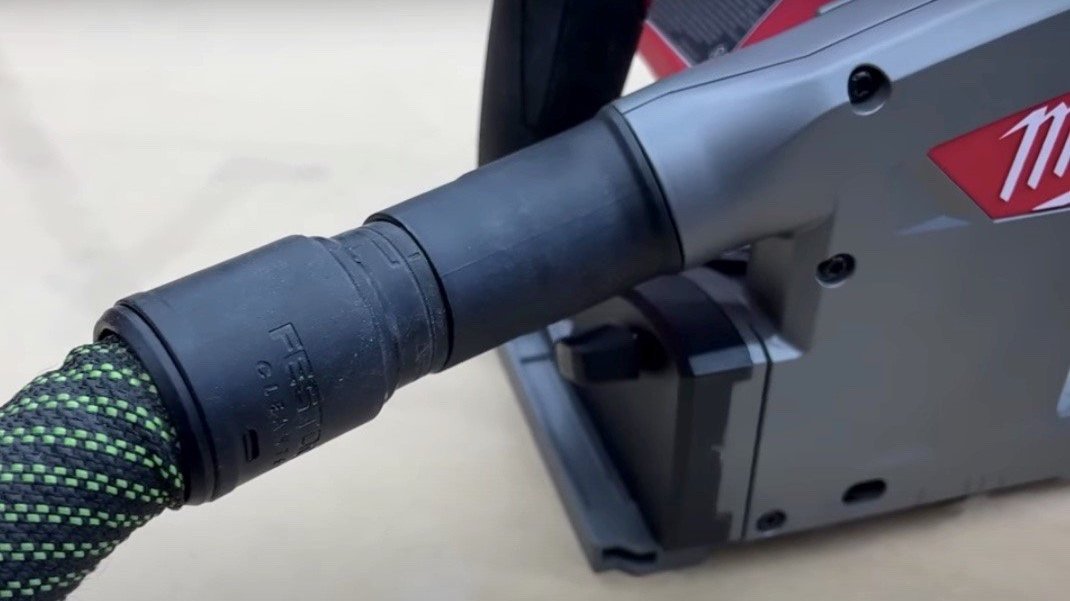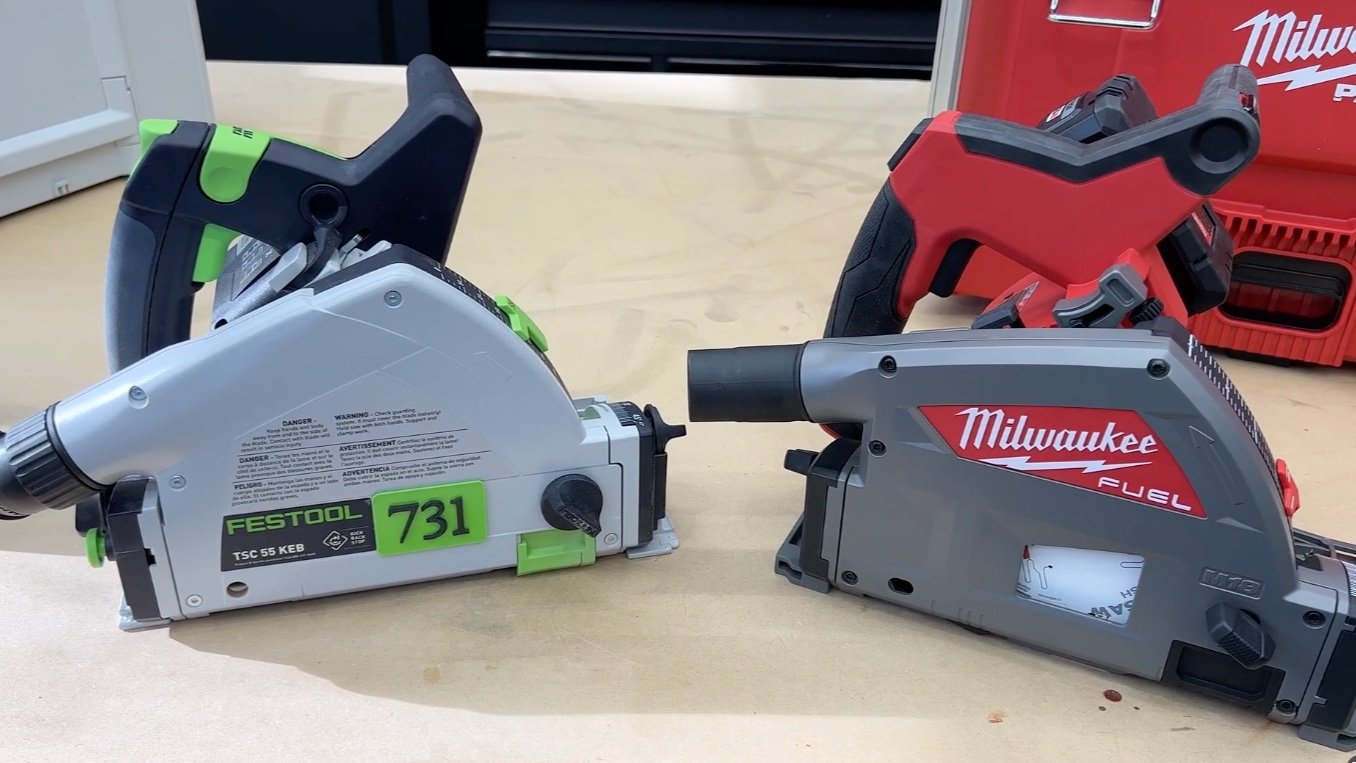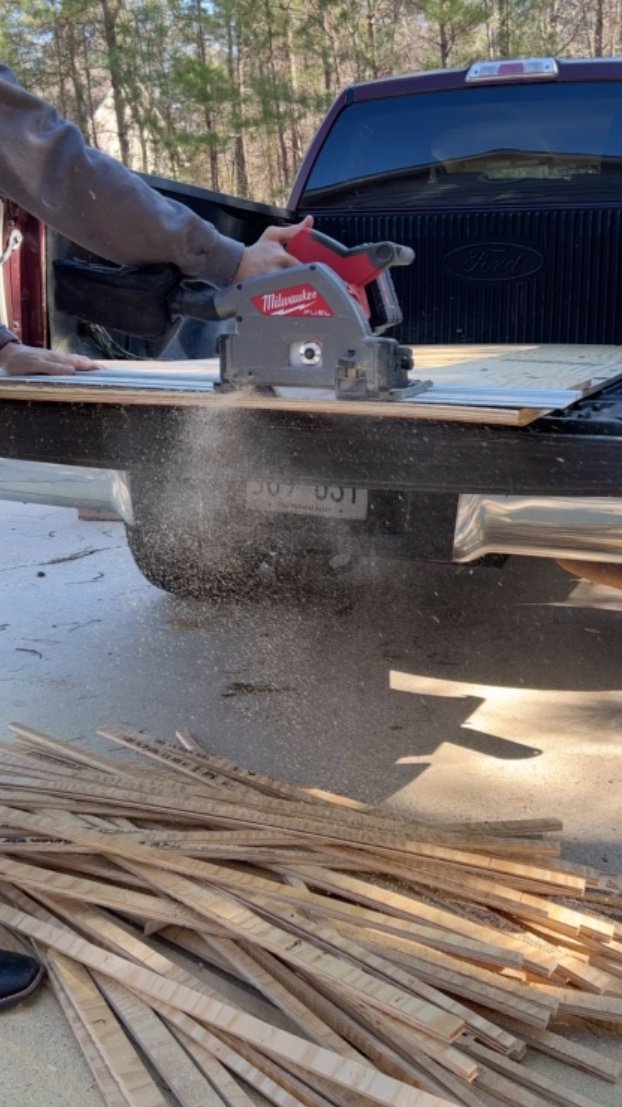Milwaukee Track Saw Review
Milwaukee Track Saw Review
It took Milwaukee years to finally come out with a track saw, and they had the advantage of watching all of their competitors put out saws with various features. They could have included these features into theirs and made it the perfect track saw, but this is what we got. I’ll go over what they got right, what they got wrong, and in the end, I’ll tell you if I’m Team Milwaukee or Team Festool.
Milwaukee Track Saw Kit (Tool Nut) - https://thetoolnut.sjv.io/x9eDyy
Milwaukee Track Saw Kit (Ohio Power Tool) https://shrsl.com/3zezi
Milwaukee Track Saw Dust Accessory Kit - https://tidd.ly/3ZZumpL
Affiliate links are used on this website to help support this website. For more information, read our affiliate disclaimer.
Full disclosure, I purchased this with my own money. I’m not sponsored by Milwaukee, and no one’s asking me to do this review.
Milwaukee vs Festool Track Saws
Your Milwaukee track saw will come in a ginormus PACKOUT box if you buy the kit. It is a little too big in my opinion, but there is a ton of space in there that includes a space for your saw, dust bag, clamps, batteries, pretty much anything you want to store with this saw. I don’t care for the padding on the lid. It’s only on there with a sticky back, and it’s likely going to come off over time. We’ll compare the Festool box later.
Festool Systainer vs Milwaukee PACKOUT size comparison
It is part of the PACKOUT system, so if you’re already in that it’s going to integrate well for you. Also, it’s just a super strong box that you could just throw in the truck, in the van, or however you’re taking this to the job site. Everything’s going to be self-contained. It holds the charger as well, and speaking of the charger, it comes with a rapid charger that will charge both the M12 and M18 batteries. Basically, you can charge two batteries at once, and it does charge up super-fast. It took less than a half an hour probably to fill the M18 all the way up. When I first plugged it in, the battery was at one bar, 5 minutes later it was showing four bars, but it wasn’t all the way charged yet. I gave it about a half hour, and it was good to go.
I previously reviewed the Kreg, the Wen, and the Festool saw all in one video, and you can check that out here - https://youtu.be/VO6_Tcjrflc&list=UULFSLClJLzdUMRMe0E4SPfc-w
This saw is on par, in my opinion, with the Festool, even with the few things it’s missing. More on that later. This is a very nice tool. If you need a track saw and you want a high-quality one, I don’t think you’ll go wrong this this one.
When you first get it, you’ll put the blade on, and it’s super simple to do. Push the lever behind the battery and push the saw down. That will lock it in place so that you can get to the arbor. There is a wrench included that’s right on the top, and once you pull the wrench out you can change the blade as normal. There is a riving knife that comes down behind the blade, and I really like that feature. The Festool does go one step further in my opinion, but the riving knife is essential to keep things from pinching that blade and causing potential kickback.
Milwaukee Track Saw has a scoring feature that stops the blade just below the surface of the cut.
A couple of other things to note. It does have a splinter guard in both black and, if you prefer, a clear window. That will drop down and help prevent splintering while you’re cutting. I like the splinter guard, and I use it on my Festool as well. One pretty cool feature this has is a scoring feature. You push a button up between the handle and the blade, and that will put the auto-stop on so the blade stops just below the surface. If you’re going to cut plywood or something that has a veneer and you don’t want it to splinter, you don’t have to worry about trying to hold it there or set a different depth. If you’ve already got your depth set at ¾” for plywood, but you do want to make that scoring cut, that’s a great way to do it.
Bevel gauge goes from -1 to 47 degrees
The markings on the depth meter are really high contrast. I like that, and I also like that you can bevel up to 48-degrees. The way that works is that there are two thumbscrews on the front and the back, that once you loosen them, it’ll tilt over. It has a stop right at 22½, and there’s a knob by the front thumbscrew that you disengage to go past the 22½. If you wanted a positive stop, you can just engage that knob again, and it’ll stop at 22½. Once you get out to 45-degrees, there’s a button behind the depth gauge that you press forward to let it go past the 45 all the way to 48-degrees. You can use that same button to angle it down to -1.
Depth gauge has two indicators, one for when the saw is on the track, the other if it is off the track.
I really like the depth gauge on this because it has two depths marked. That’s an indicator for if it’s off the track, you’ll use the single bar on one side of the gauge, and if it’s on the track you’ll use the two bars on the other side. The depth gauge is very easy to move, and it has positive stops at each of those marks. There’s also a fine-tuning knob that you can loosen or tighten to adjust the plunge, so you can dial that in to get the exact right depth that you want, every single time. That’s what makes track saws so awesome.
The kit I got came with an M18 high-output XC6.0 battery, whatever that means. It’s a big heavy battery that gives it plenty of power. This is a variable-speed saw with a brushless motor. That means the battery run-time is going to last a little bit longer. It’s super easy to install the battery, and you’re ready to roll.
The overall fit and finish on the saw is awesome. The outer shroud is aluminum, and so is the base plate. The rest of it is plastic or rubbery for grips. It’s a very well-made tool, I think.
Milwaukee Track Saw base plate
On the bottom plate, in the channel that rides along the track, there’s two sets of bars with a cam connected to a knob on the top of the plate. Those knobs twist to tighten and loosen the bars along the track channel. You want to tighten those bars up just enough so that the saw is snug on the track and not wiggling. You just don’t want to over-tighten them and make the saw hard to push. Just behind those two knobs, there’s another knob at the back for the anti-tip feature. You twist that knob until a little piece of metal sticks out under the plate, which will catch in the track. That way, when you bevel over to 45-degrees, it won’t tip over on you. Some saws have a tendency to do that, and this feature will prevent that from happening.
As far as dust collection goes, the Festool hose will fit on the dust collection port nice and snug. It doesn’t lock in the way it does on the Festool track saw, which has grooves to lock it in. It’s so snug, though, I don’t think the hose is going to come out.
Both the Milwaukee and Festool saws come in nice boxes. I prefer the Festool box just because it’s smaller and takes up less room, especially in a shop like this. I need all the space I can get. The Milwaukee box takes up a massive amount of space. In the bed of a truck or a work van, this is going to take up a lot of room there, too. Although, I do think the Milwaukee box is a better, more durable box.
As far as warranty goes, with Festool you’re getting a 3-year warranty. With Milwaukee, you’re getting a 5-year warranty on the tool and a 3-year warranty on the battery. Milwaukee wins on the warranty.
Pricing is where it starts getting a little bit different, but also similar enough that it makes the decision hard. For just the bare tool, you’ll pay $399 for the Milwaukee and $549 for the Festool. I picked up both saws as part of a kit that came with batteries, charger, and a 55” track. For the kits, the pricing is very close - $879 for the Festool and $859 for the Milwaukee. That’s where I think a lot of people are going to have trouble choosing if they don’t already have either platform.
Milwaukee M18 Track Saw with 55 inch track
One thing to consider with price is the cost of accessories moving forward. Both tools come with a 55” track, which is not enough to make a full 8-foot rip down a sheet of plywood. In Milwaukee’s case, you can pick up an additional 55” track for $129. The Festool track at the same length is going to cost you $155. If you want a shorter track, Milwaukee has a 31” track for $79, where the Festool has a 32” track for $105. Where the pricing difference really gets ugly is if you get the 106” track that both saws have. The Milwaukee will cost you $250, where the Festool is $465. So, between the two kits with an extra 55” track, there’s really not a lot of difference as far as price goes. If I’m advising you on what tracks to get when you buy your saw, at least get two 55” tracks or the 106” track. That will allow you to cut longer stock when you need to.
The only part of these tracks that’s not compatible is the anti-tip feature. For the Milwaukee track, there’s a groove that the pin slides into. That groove is not on the Festool track. Other than that, this saw will ride on either track and cut straight lines just like any other track. You just lose that anti-tip feature. If you connect the two tracks together, the rail on the Milwaukee track is slightly thicker than the rail on the Festool track. That mean once you tighten the saw down for the Milwaukee track and you slide it up to the Festool track, it will stop until you loosen those rail bushings. Just a word of caution if you’re trying to use two different tracks.
Milwaukee M18 Track Saw inside storage PACKOUT box
The Milwaukee uses a 6½” blade, where the Festool uses a 6¼” blade.
If you consider cut depth, you’re going to get about ⅛” more cut out of that bigger Milwaukee blade. At 45-degrees, the Festool cut depth is 1 11/16” max, but the Milwaukee’s depth has not been published.
Where you start to see the difference in these two saws is the features. The Festool does have two features the Milwaukee does not. Number one is the Festool has an anti-kickback. If it gets bound up and it starts to kick back, the anti-kickback stops the motor, very similar to a SawStop. That’s an awesome feature to have, and Milwaukee doesn’t have that. Milwaukee does have that riving knife to help prevent that binding, though.
The Number two feature, which I didn’t realize was a big deal until I got it, the Festool batteries are Bluetooth capable. What that means is it integrates perfectly with the Festool dust extractor. When I have the Bluetooth connected, any time I power the saw on, it automatically powers on the dust extractor. It’s a convenience thing, but it is super handy to have. We can get around that if you have a Festool dust extractor with the Bluetooth button that attaches to the hose. When you push the button, that will power on the dust extractor also.
Now, a couple of complaints I have about the Milwaukee. Milwaukee had years to come out with this thing. They were one of the last big tool companies to come out with a track saw. Ryobi beat them on putting out a track saw (c’mon, man). They had the opportunity to see what everybody else was offering and incorporate into their tool. There’s no innovative feature here; nothing that’s mind-blowing or outstanding. And maybe that’s just it, based on what was working well on what everybody else made. It’s a good tool; don’t get me wrong. I just wish there was something more innovative here, similar to the anti-kickback on the Festool, especially for the price-point you’re paying for this tool.
There are two interesting things about the track saw, one of which isn’t really obvious. On the bottom plate, there a little notch on the front of the blade-side. If you’re using this as just a saw without the track, the notch shows you exactly where the blade is going to go. The inside of the notch shows where the inside of the blade will be at 90-degrees. The outside edge of the notch is where the inside of the blade will be at 45-degrees. The other thing I like is that this blade has a brake. In other words, as soon as you let off the trigger, the blade stops almost immediately.
Milwaukee track saw has an anti tip feature that only works with Milwaukee brand tracks. As you can see here on a Festool track, the anti tip feature has nothing to engage. Otherwise, the Milwaukee saw works on a Festool track.
The edge of the track that the blade is against is the splinter-guard, and it will need to be cut the first time so that it fits your blade exactly. This is a very good track. It has a non-slip grip on the bottom that helps keep it in place. So, you don’t need to use clamps, especially if you’re just cutting flat sheet goods. However, this kit did come with clamps if you just want to be sure it’s not going to move.
the notch on front gives an indicator of where the blade is going to cut when off the track
On dust collection, I did notice quite a bit of dust coming out when cutting some MDF. That’s fairly normal, especially on MDF when there’s no cover over that arbor hole like I have on my Festool. My friend over at Wittworks sells covers for the arbor hole that help reduce the amount of dust that escapes.
Milwaukee track saw cutting 8/4 walnut
With cordless track saws, one thing I always worry about is power. I tested it on an 8/4 chunk of walnut to see what happens. I also tested it with both the XC 5.0 battery, as well as the XC 6.0 high output battery. There was a noticeable difference between the high output and the regular 5.0 battery. It wasn’t significant, but it was noticeable. As far as cut quality, the saw did well. There was no burning or scarring. There was plenty of power as long as you give the saw time to cut the wood. It was no different than with the Festool saw.
Milwaukee track saw battery lasts a long time. I cut 302 feet on a single charge.
For battery life, I tested a fully charged battery by cutting 4’ strips out of sheet of sheet of plain, cheap plywood. I was able to cut 75 full 4’ strips that are between 1’ and 2” wide, and I made it through half of another strip when the battery died. That’s a total of 302’ that I was able to cut on a single battery charge. For cut quality, there is a little burning or splintering here and there, but some it is as clean as a whistle, and this was really bad plywood.
If you’re in the market for a higher-end track saw, these two are the top in my opinion. If you’re already on one platform or the other, it makes sense to go with the saw in that platform. If you’re not on either platform, that’s a decision you’ll have to make based on the Pros and the Cons. Personally, I’m gonna lean toward the Festool simply because of the anti-kickback and the Bluetooth, and Festool’s just a system I’m already in.
But, the Milwaukee’s a great saw, and I’ll probably interchange these for the next few months just to see which one stays in the shop.
You can watch my full video review of the Milwaukee M18 Track saw here - https://youtu.be/eUbb2fCgaYE&list=UULFSLClJLzdUMRMe0E4SPfc-w

















